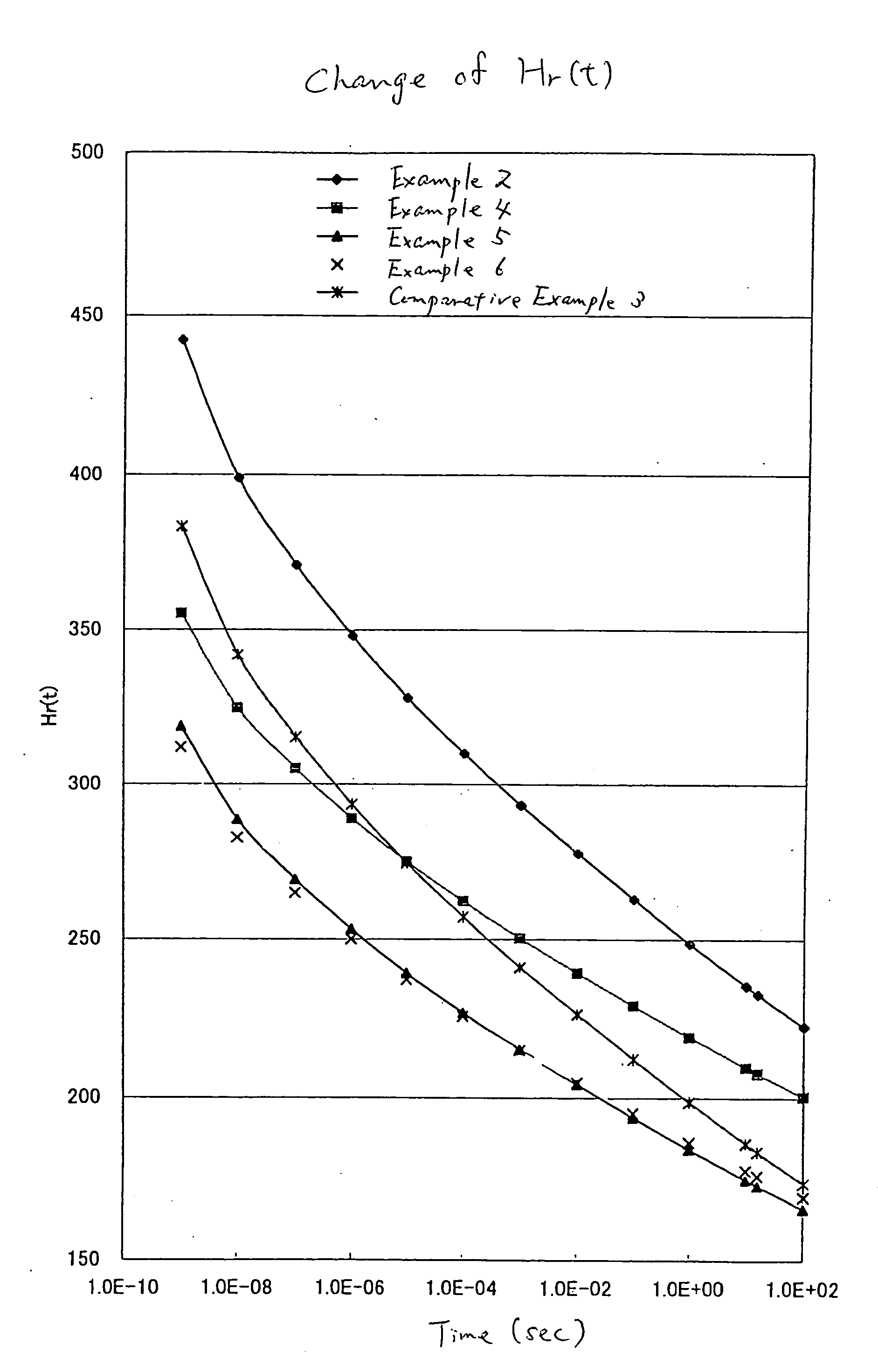Magnetic recording medium
a magnetic recording and recording medium technology, applied in the field of magnetic recording mediums, can solve the problems of reducing the requiring a large system capacity and high transferring rate, and unable to provide the desired coercive force, etc., and achieves low signal attenuation, high output and c/n ratio, and high density recording
- Summary
- Abstract
- Description
- Claims
- Application Information
AI Technical Summary
Benefits of technology
Problems solved by technology
Method used
Image
Examples
example
[0078] The invention will be further described in the following examples, but the invention is not limited thereto.
[0079] As materials of a hexagonal ferrite magnetic powder there were measured out various compounds in the following formulation as calculated in terms of oxide. The amounts X, Y and Z of the following components and the magnetic powders thus obtained (Production Examples 1 to 6) are set forth in Table 1.
B2O34.7molsBaCO310.0molsFe2O3XmolsCoCO3YmolsZnOZmolsNb2O5Wmols
[0080] B2O3, BaCO3 and Fe2O3 were thoroughly stirred by a powder mixer. To the mixture were then added reducing elements (CoCO3, ZnO, Nb2O5). The mixture was further stirred. The mixture was put in a crucible made of by Pt—Rh with an agitator where it was then melted at a temperature of from 1,300° C. to 1,340° C. for 3 hours. The molten mixture was then ejected into the gap between two cooling stainless steel rolls which were rotating to obtain an amorphous material which was then ground. Subsequently, t...
examples 1-7
Comparative Examples 1-3
[0085] The lower non-magnetic layer coating solution 1 thus obtained was spread over a polyethylene terephthalate support having a thickness of 7 μm to a dry thickness of 1.5 μm. Wet simultaneous multi-layer coating was immediumtely conducted by controlling the spread of the magnetic layer such that a predetermined thickness of magnetic layer was reached while the lower non-magnetic coat layer thus spread was wet. The coated material was then passed through an orienting apparatus while the two layers were wet to undergo longitudinal orientation. During this orientation procedure, the coated material was passed through a rare earth magnet (surface magnetic flux density: 500 mT) and then through a solenoid magnetic (magnetic flux density: 500 mT). The material thus oriented was then dried until in the solenoid to an extent such that it cannot be oriented back to the original state. The magnetic layer was then further dried. The coated material was then wound. ...
examples 8 , 9
Examples 8, 9
Comparative Example 4
[0086] The coating solution of lower non-magnetic layer formulation 2 thus obtained was spread over a polyethylene terephthalate support having a thickness of 68 μm to a dry thickness of 1.5 μm. Wet simultaneous multi-layer coating was immediumtely conducted by changing the spread of the magnetic layer coating solution of magnetic coating solution formulation 2 such that the thickness of the magnetic layer was varied while the lower non-magnetic coat layer thus spread was wet. The coated material was then passed through a rare earth magnetic having the same poles disposed opposed to each other at a central magnetic field of 398 kA / m while the two layers were wet to undergo longitudinal orientation. The coated material was then passed through two magnetic field alternating magnetic field generators having a magnetic field intensity of 24 kA / m at a frequency of 50 Hz and 12 kA / m at a frequency of 50 Hz, respectively, to undergo random orientation. As...
PUM
| Property | Measurement | Unit |
|---|---|---|
| diameter | aaaaa | aaaaa |
| particle volume | aaaaa | aaaaa |
| thickness | aaaaa | aaaaa |
Abstract
Description
Claims
Application Information
 Login to View More
Login to View More - R&D
- Intellectual Property
- Life Sciences
- Materials
- Tech Scout
- Unparalleled Data Quality
- Higher Quality Content
- 60% Fewer Hallucinations
Browse by: Latest US Patents, China's latest patents, Technical Efficacy Thesaurus, Application Domain, Technology Topic, Popular Technical Reports.
© 2025 PatSnap. All rights reserved.Legal|Privacy policy|Modern Slavery Act Transparency Statement|Sitemap|About US| Contact US: help@patsnap.com

